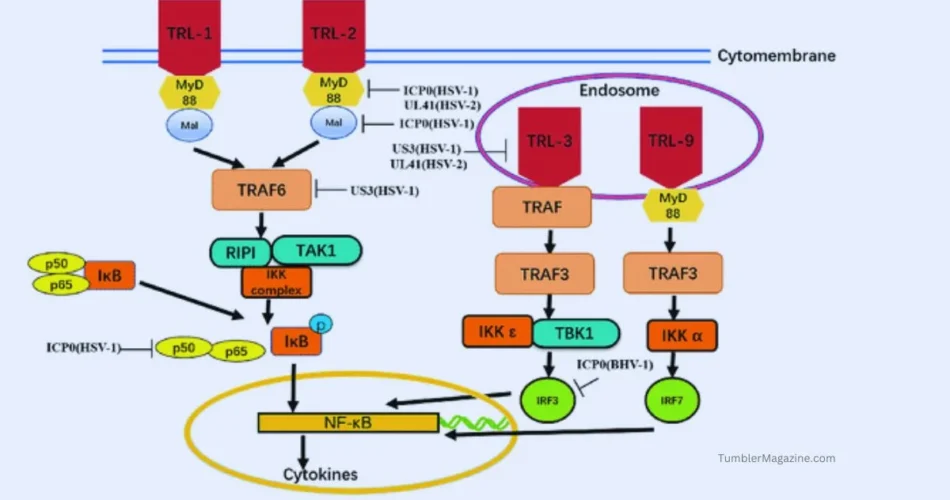Welcome to the exciting world of TIRAP, where innovation meets communication networks head-on! In this blog post, we will delve into how TIRAP is revolutionizing the way we connect and interact in today’s fast-paced digital landscape. From its role in inflammation mechanisms to its impact on molecular interactions, TIRAP is a game-changer that is shaping the future of communication technology. Join us as we explore the ins and outs of TIRAP and uncover its profound implications for the industry. Let’s dive in!
Table of Contents
Introduction
Welcome to the world of TIRAP, a revolutionary technology that is transforming communication networks as we know them. In today’s fast-paced digital era, seamless and efficient communication is key to success in any industry.
TIRAP, short for Toll/interleukin-1 receptor domain-containing adaptor protein, plays a crucial role in facilitating signal transduction pathways within cells. By understanding its mechanisms and molecular interactions, we can unlock new possibilities for enhancing network connectivity and data transmission.
With TIRAP at the forefront of innovation, businesses can achieve higher levels of efficiency and productivity by optimizing their communication systems. Whether it’s improving response times or streamlining processes, TIRAP offers a pathway towards enhanced connectivity and collaboration.
Stay tuned as we delve deeper into the realm of TIR-AP and explore its impact on shaping the future of communication networks worldwide. Join us on this exciting journey towards unlocking the full potential of this groundbreaking technology!
TIRAP in the Mechanism of Inflammation
TIRAP, also known as Toll/interleukin-1 receptor domain-containing adaptor protein, plays a crucial role in the mechanism of inflammation within the immune system. When pathogens invade the body, TIR-AP acts as a signaling molecule that triggers an inflammatory response to fight off infections.
By interacting with various receptors and proteins involved in immunity, TIR-AP helps coordinate the activation of inflammatory pathways. It acts as a bridge between cell surface receptors and intracellular signaling molecules, enabling rapid responses to microbial threats.
Through its involvement in signaling cascades triggered by pathogens, TIR-AP contributes to the production of pro-inflammatory cytokines and chemokines. These molecules are essential for recruiting immune cells to sites of infection and promoting inflammation to eliminate invaders effectively.
Understanding how TIR-AP functions in the mechanism of inflammation is essential for developing targeted therapies that modulate immune responses without causing excessive tissue damage. Researchers continue to explore its intricate role in maintaining immune homeostasis and combating infectious diseases.
TIRAP and Key Molecular Interactions
TIRAP plays a crucial role in communication networks by interacting with key molecules within the immune response pathway. One of these interactions involves the Receptor for Advanced Glycation End-Products (RAGE), which amplifies inflammatory responses when triggered by TIR-AP. This interaction highlights how TIR-AP contributes to the regulation of immune reactions.
Another important molecular link is between TIR-AP and Caspase-1, an enzyme involved in initiating inflammation. By associating with Caspase-1, TIR-AP further modulates the immune system’s response to pathogens or injuries. Understanding this interaction enhances our comprehension of how TIR-AP influences inflammatory processes at a molecular level.
Moreover, TIRAP interacts with B-Cell Adaptor for Phosphoinositide 3-Kinase (BCAP) to regulate signaling pathways that coordinate immune responses. This intricate interplay showcases the complexity of molecular interactions orchestrated by TIR-AP in shaping effective communication networks within the body.
TIRAP and Receptor for Advanced Glycation End-Products (RAGE)
TIRAP plays a crucial role in the activation of immune responses and signaling pathways. One significant interaction is with the Receptor for Advanced Glycation End-Products (RAGE). RAGE is known for its involvement in inflammatory processes and cellular stress responses.
When TIR-AP binds to RAGE, it triggers a cascade of intracellular events that lead to the activation of pro-inflammatory cytokines. This interaction enhances the immune response against pathogens and promotes tissue repair mechanisms.
The synergy between TIR-AP and RAGE highlights their importance in modulating innate immunity and inflammation. Understanding this molecular partnership can provide valuable insights into developing targeted therapies for inflammatory diseases.
The collaboration between TIR-AP and RAGE underscores their significance in orchestrating immune responses and maintaining tissue homeostasis.
TIRAP and Caspase-1
TIR-AP plays a crucial role in the activation of Caspase-1, an enzyme involved in initiating inflammatory responses. When TIR-AP recognizes specific signals from pathogens, it triggers a cascade of events leading to the activation of Caspase-1. This activation process is essential for the immune system’s ability to target and eliminate harmful invaders effectively.
Caspase-1 acts as a key player in inflammation by promoting the maturation and release of pro-inflammatory cytokines like interleukin-1β (IL-1β) and IL-18. These cytokines are vital for coordinating immune responses against infections or injuries within the body. The interaction between TIR-AP and Caspase-1 highlights the intricate molecular mechanisms that regulate our body’s inflammatory processes.
Understanding how TIR-AP influences Caspase-1 activation provides valuable insights into developing targeted therapies for diseases characterized by dysregulated inflammation. By unraveling these molecular interactions, researchers can potentially identify new treatment strategies to modulate inflammatory responses effectively.
TIRAP and B-Cell Adaptor for Phosphoinositide 3-Kinase (BCAP)
TIRAP plays a crucial role in the communication networks of our immune system. One key molecular interaction involves its connection with the B-Cell Adaptor for Phosphoinositide 3-Kinase (BCAP). BCAP is a signaling protein that regulates various immune responses, including B-cell activation and antibody production.
When TIR-AP interacts with BCAP, it triggers a cascade of events that ultimately lead to the activation of specific pathways within immune cells. This activation is vital for mounting an effective defense against pathogens and maintaining overall immune homeostasis.
Understanding the intricate relationship between TIR-AP and BCAP can provide valuable insights into how these molecules collaborate to modulate immune responses. Research in this area not only enhances our comprehension of immunological processes but also opens up new possibilities for developing targeted therapies to treat inflammatory disorders and autoimmune diseases.
Computational Predictions and Future Implications
Computational predictions using TIR-AP are paving the way for groundbreaking advancements in communication networks. By analyzing data and patterns, researchers can anticipate potential outcomes and trends with greater accuracy. This predictive power enables companies to make informed decisions that optimize network performance and efficiency.
The future implications of these computational insights are immense. Businesses can proactively address issues before they arise, ensuring seamless operations and enhanced user experiences. With TIR-AP at the forefront of this technological revolution, we can expect a more reliable, secure, and responsive communication infrastructure in the years to come.
By harnessing the capabilities of computational modeling through TIR-AP, organizations can stay ahead of the curve in an ever-evolving digital landscape. The integration of predictive analytics into network management strategies is reshaping how we approach communication technology on a fundamental level.
Building Workforce with TIRAP
Are you looking for a way to enhance your workforce and empower veterans in the communication network industry? Look no further than TIR-AP. What exactly is TIR-AP, you may ask? It stands for Telecommunications Industry Registered Apprenticeship Program.
TIRAP offers numerous benefits for veterans seeking to transition into civilian roles within the telecommunications sector. By providing structured training programs and hands-on experience, TIR-AP equips veterans with the skills needed to excel in this thriving industry.
Employers can also reap the rewards of participating in TIR-AP. By hiring apprentices through this program, companies not only support veteran integration but also gain access to a pool of highly trained and motivated individuals ready to contribute effectively from day one.
What Is TIRAP?
TIRAP, which stands for Toll/interleukin-1 receptor (TIR) domain-containing adaptor protein, plays a crucial role in the immune response within our bodies. Specifically, TIR-AP acts as an adapter molecule that helps transmit signals from receptors on the cell surface to trigger downstream inflammatory responses.
This protein is essential for proper communication between cells involved in the immune system’s defense mechanisms. By facilitating these interactions, TIR-AP contributes to mounting effective responses against pathogens and foreign invaders.
Understanding the function of TIR-AP is key to comprehending how our immune system responds to various stimuli and maintains homeostasis. Research into this area continues to shed light on its significance in regulating inflammation and immunity pathways.
As we delve deeper into the intricate workings of TIR-AP, we uncover its pivotal role in orchestrating cellular responses that are vital for our overall health and well-being.
Benefits For Veterans
Transitioning from military to civilian life can be challenging for veterans, but organizations like TIR-AP are offering a lifeline. For veterans looking to build new skills and embark on a rewarding career path in the communication industry, TIR-AP provides specialized training programs tailored to their unique needs. These programs not only equip veterans with technical knowledge but also offer them valuable certifications that enhance their job prospects.
Moreover, by participating in TIR-AP initiatives, veterans gain access to a supportive network of professionals who understand the challenges they face during this transition period. This sense of camaraderie fosters a conducive environment for learning and growth, allowing veterans to thrive in their new careers.
Furthermore, TIRAP’s focus on workforce development ensures that veterans receive ongoing support and guidance as they navigate through the intricacies of the communication industry. By tapping into this resource pool, veterans can leverage their military experience and transferable skills to excel in their roles within this dynamic sector.
Employer Participation and Benefits
Employer participation in TIRAP programs brings numerous benefits to both companies and employees. By investing in training and development opportunities for their workforce, employers can enhance the skills of their staff members, leading to increased productivity and efficiency within the organization. Additionally, participating in its initiatives allows companies to stay at the forefront of technological advancements in communication networks.
Moreover, by supporting its training for their employees, employers demonstrate a commitment to professional growth and career advancement. This can boost employee morale and loyalty while attracting top talent seeking continuous learning opportunities. Furthermore, businesses that engage with TIR-AP contribute to building a skilled workforce capable of meeting industry demands and driving innovation.
Employer involvement in TIR-AP not only benefits individual employees but also strengthens the communication network sector as a whole through enhanced knowledge sharing and skill development.
Conclusion & Implications
In today’s fast-paced world, where communication networks play a crucial role in connecting people and information, TIR-AP stands out as a key player in revolutionizing the landscape. With its intricate molecular interactions and potential for computational predictions, TIR-AP is paving the way for more efficient and effective communication systems.
The implications of TIR-AP extend beyond just technology. By building a workforce that understands the significance of this protein, we can empower veterans with valuable skills and provide opportunities for employer participation. This not only enhances job prospects but also contributes to overall industry growth and innovation.
As we look towards the future of communication networks, it is clear that TIR-AP will continue to play a pivotal role in shaping how we connect and communicate. By leveraging its capabilities and fostering a workforce that embraces its potential, we can unlock new possibilities and drive advancements in the field. The impact of TIR-AP goes far beyond just improving network efficiency – it has the power to transform how we interact with each other on a global scale.

